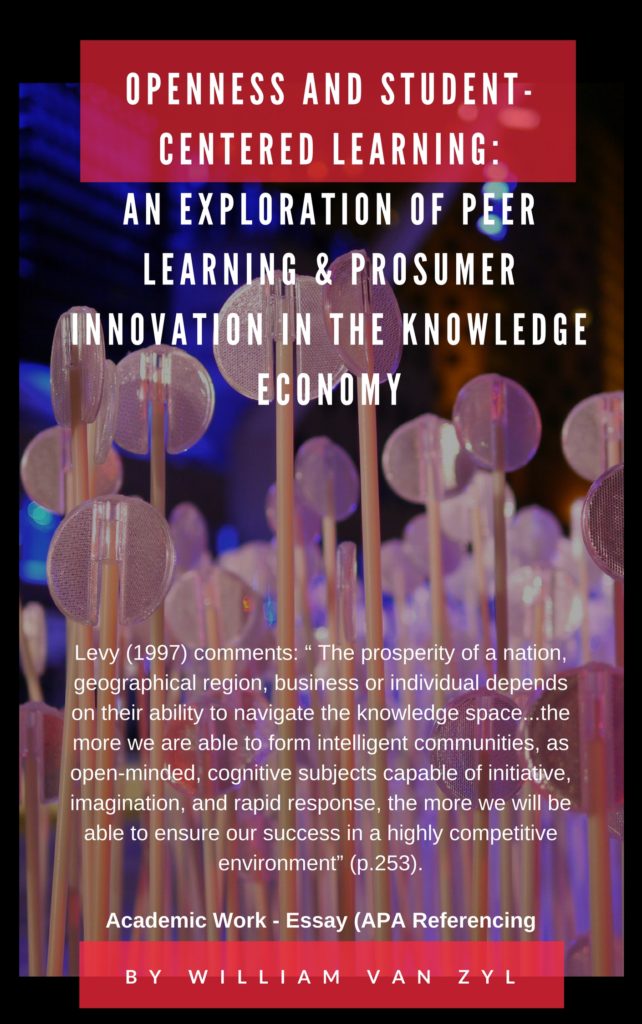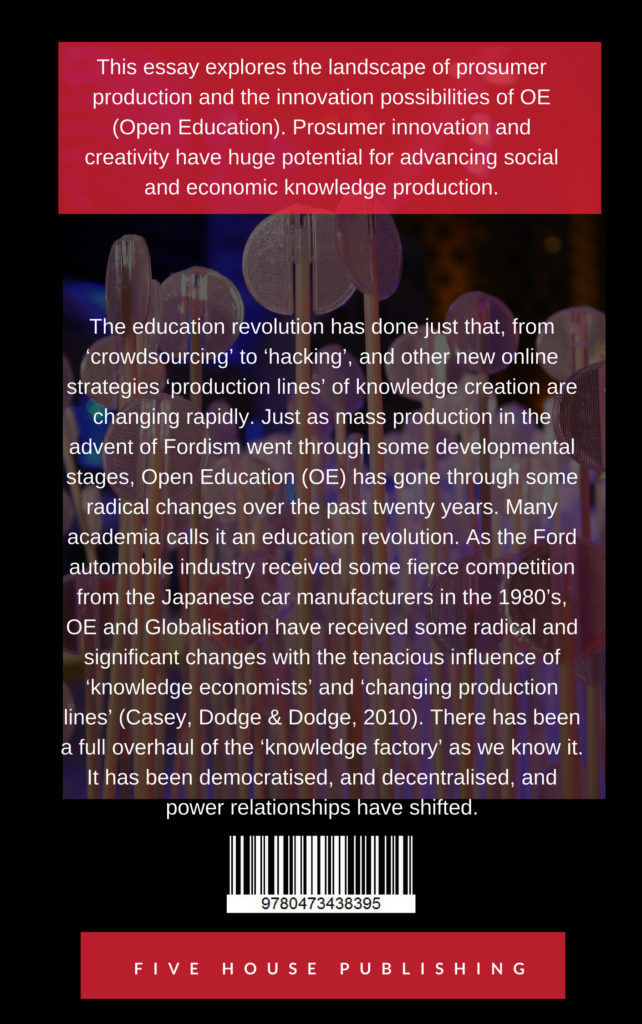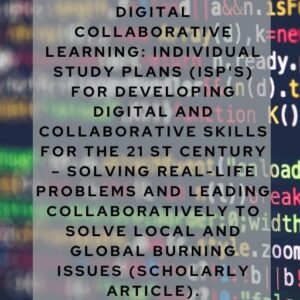Original price was: $2.99.$0.99Current price is: $0.99.
Description of book: ESSAY ACADEMIC PAPER (APA Referencing)
Words= 6000
56 x pages (size A4) font size 14 pt
Contents
…………………………………………………………………………….. 10
Global Citizenship- Jenny Buccos. 15
https://youtu.be/6jjLHmyBs7o. 15
Yochai Benkler: How cooperation triumphs over self-interest. 23
https://youtu.be/dPbE3WieoUo 23
What is Collective Intelligence? https://youtu.be/0Pb-brVzwjw. 35
Essay
Excerpt:
As explained the prosumer innovation and P2P collaboration are levelling the power relationships of the knowledge industry and are contributing continuously by adding, changing, and leading mass production by means of new models of mass collaboration. The need of consumers to become prosumers arises when the influence and the need for peer influence are detected in consumers hacking into the power, design, and manufacturing processes. A prominent design website Designboom.com (2014) reports on ‘hacking’ as follow:
“The term hacking holds many varying definitions. The predominant meaning of the word used to refer to an illegal activity performed by computer experts, however, a new definition is slowly taking over. This new form of hacking is not done by expert computer users or digital criminals but is in fact done by everyday people. This new terminology for hacking refers to the act of modifying or customizing everyday products to improve their functionality, repurpose them or just for fun” (Designboom, 2014).
“‘Crowdsourcing’ (Howe 2006) is an [another] case of such innovative collective intelligence [development]. It leverages the wisdom of crowds (Surowiecki, 2004) and is already changing the way groups of people produce knowledge, generate ideas and makes them actionable. A very famous example of a crowdsourcing outcome is the distributed encyclopedia ‘Wikipedia’. Published research agendas are asking how techniques are addressing ‘the crowd’ can be applied to nonprofit environments; namely universities, and fundamental research in general” (Buecheler, Sieg, Fuchlin & Pheifer, 2010, p. 679).
REFERENCES
Bauwens, M. (2014). What is P2P? Michael Bauwens interviewed by Julie Tran, February 5, 2014. Retrieved from http://integral-options.blogspot.co.nz/2014/02/what-is-p2p-michel-bauwens-interviewed.html
Benkler, Y. (2006). The wealth of networks: How social production transforms markets and freedom (1st edition.). New Haven, Conn: Yale University Press.
Brown, J. & Iiyoshi, T. (2008). Opening up Education. The Collective Advancement of Education through Open Technology, Open Content, and Open Knowledge. Retrieved on April 21, 2014, from:
https://mitpress.mit.edu/sites/default/files/titles/content/9780262515016_Open_Access_Edition.pdf
Brown, J. S., & Adler, R. (2008), January/February. Minds on fire: Open education, the long tail, and learning 2.0. Educause Review, 43,1.
Buecheler, T., Sieg, J. H., Fuchslin R. M., Pheifer, R. (2010). Crowdsourcing, Open Innovation and Collective Intelligence in the Scientific Method: A Research Agenda and Operational Framework. ALIFE, 2010 – mitp-web2.mit.edu.
Retrieved on May 1, 2014, form http://mitp-web2.mit.edu/sites/default/files/titles/alife/0262290758chap123.pdf
Casey, B., Dodge, J. & Dodge, H. (2010). Henry Ford and Innovation, ‘From the curator’. The Henry Ford. Retrieved on April 20, 2014, from:
http://www.thehenryford.org/education/index.aspx
Designboom (2014). Architectural and product design website. Retrieved on April 26, 2014, from http://www.designboom.com/contemporary/product_hacking.html
Jorgenson, S., Shultz, L. (2012). Global Citizenship Education (GCE) in Post-Secondary. Institutions: What is Protected and what is Hidden under the Umbrella of GCE? Journal of Global Citizenship & Equity Education, Vol. 2, No 1 (2012). Retrieved from http://journals.sfu.ca/jgcee/index.php/jgcee/article/viewArticle/52/26 on May 1, 2014.
Keller, H.(2013). Broadband for schools: Do we need Gbps Bandwidth? ETC Journal: A Journal for Education, Technology & Change. Posted by JimS on August 3, 2013. Retrieved on May 1, 2014, from http://etcjournal.com/2013/08/03/broadband-for-schools-do-we-need-gbps-bandwidth/
Lévy, P. (1997). Collective Intelligence. Cambridge, MA: Perseus Books, 1997.
Lucas, R. E., Jr. (2002). Lectures on Economic Growth. Cambridge: Harvard University Press. pp. 109–10.
Nanney, B. (2004). Student-Centered Learning. Retrieved on April 24, 2014, from:
http://ollyusofalhaj.ipgkti.edu.my/sumber/resosbestari/PENDEKATAN/scl/7 SCL-Nanney.pdf
Peer to Peer University (P2PU). (2014). Retrieved on April 24, 2014, from
Peters, M., Britez, R.G. (2008). Open Education and Education for openness. Educational future; Rethinking theory and practice (The history and emergent paradigm of open education). Published by: Sense Publishers, P.O. Box 21858, 3001 AW Rotterdam, the Netherlands http://www.sensepublishers.com
Popper, K. (1966). The Open Society and Its Enemies. Fifth edition. Retrieved on April 26, 2014, from:
http://www.inf.fu-berlin.de/lehre/WS06/pmo/eng/Popper-OpenSociety.pdf
P2P Foundation. (2014). What this essay is about. Retrieved on April 23, 2014, from:
http://p2pfoundation.net/What_this_essay_is_about
SlideShare (2014). What is SlideShare? Retrieved on April 26, 2014, from http://www.slideshare.net/about
Tapscott, D. & Williams, A. (2006). Wikinomics: How mass collaboration changes everything. New York: Portfolio.
Von Hippel, E. (2005). Democritizing innovation. Cambridge, MA: MIT Press.
APA REFERENCING
Van Zyl, W. N. (2014). Openness and Student-Centered Learning: An Exploration of Peer Learning & Prosumer Innovation in the Knowledge Economy (Essay).Published by Five House Publishing – https://fivehousepublishing.com/. Ref: Academic work.
Description
Introduction:
Imagine yourself behind a conveyor belt with an air powered tool in your hand assembling vehicles for Toyota in a factory in Japan. I am sure that after several years working for the company, you would appreciate if your employer would ask you, “How could we improve this assembly line?”, and “What are your ideas on changing the way we assemble here?”, and “I want you to collaborate with the other workers and come up with some innovative ideas to improve or change the way we do things here?”. These are just the type of questions the world out there is asking the world-wide community (internet users).
Excerpt 1:
The education revolution has done just that, from ‘crowdsourcing’ to ‘hacking’, and other new online strategies ‘production lines’ of knowledge creation are changing rapidly. Just as mass production in the advent of Fordism went through some developmental stages, Open Education (OE) has gone through some radical changes over the past twenty years. Many academia calls it an education revolution. As the Ford automobile industry received some fierce competition from the Japanese car manufacturers in the 1980’s, OE and Globalisation have received some radical and significant changes with the tenacious influence of ‘knowledge economists’ and ‘changing production lines’ (Casey, Dodge & Dodge, 2010). There has been a full overhaul of the ‘knowledge factory’ as we know it. It has been democratised, and decentralised, and power relationships have shifted.
Excerpt 2:
The education revolution has done just that, from ‘crowdsourcing’ to ‘hacking’, and other new online strategies ‘production lines’ of knowledge creation are changing rapidly. Just as mass production in the advent of Fordism went through some developmental stages, Open Education (OE) has gone through some radical changes over the past twenty years. Many academia calls it an education revolution. As the Ford automobile industry received some fierce competition from the Japanese car manufacturers in the 1980’s, OE and Globalisation have received some radical and significant changes with the tenacious influence of ‘knowledge economists’ and ‘changing production lines’ (Casey, Dodge & Dodge, 2010). There has been a full overhaul of the ‘knowledge factory’ as we know it. It has been democratised, and decentralised, and power relationships have shifted.







